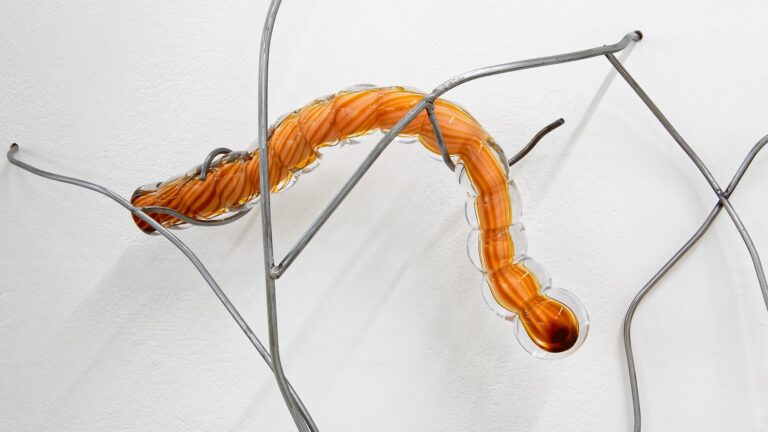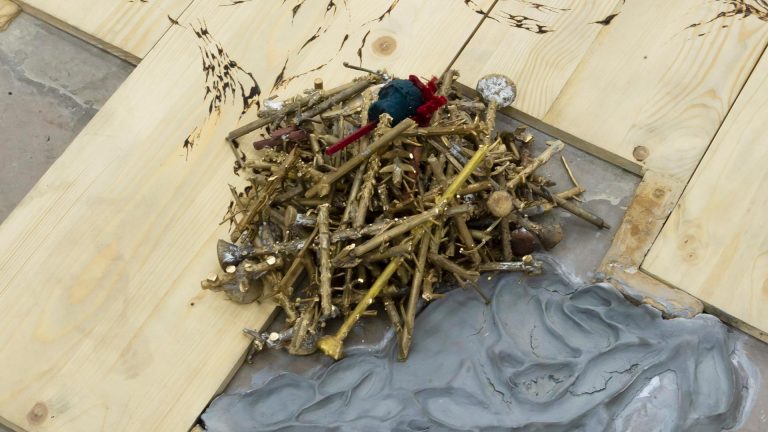Artist: Naoki Sutter-Shudo
Exhibition title: Mœurs
Venue: Crèvecoeur, Paris, France
Date: June 21 – July 21, 2018
Photography: © Aurélien Mole, all images copyright and courtesy of the artist and Crèvecoeur, Paris
Other days, other ways. During the second world war in France, non-ferrous metals were rare. On October 11th 1941, the Vichy government decreed: “there shall be a removal of statues and monuments made of copper alloys situated in public places and administrative sites which have no artistic or historic interest.” This historic or artistic interest was to be decided by Marshal Pétain. Most of them were never to be replaced. Quelques sculptures parisiennes enlevées en 1942-43, 2018. Unsurprisingly, they depict characters who did not figure in Pétain’s personal pantheon: such as Camille Desmoulins, Rousseau, Marat, Jean-Sylvain Bailly, Diderot, Charles Fourier, Chevalier de la Barre, Condorcet, Louis Blanc, or General Dumas. To cast down, or not cast down – the question is still current. And what order to adopt?
Days, ways. Bal ANF 2017, 2018. As in a comparative diagram of the planets in the solar system, or a touch screen with numerous windows, Naoki Sutter-Shudo has grasped the efforts of aristocratic reproduction reproduced in the scenes of the annual ball of the Association d’Entraide de la Noblesse Française.
Dox/Dose, 2018. One of the exhibited sculptures displays these two words stretched out, one opposite from the other. “To dox” means deliberately divulging online private information about an individual so as to harm him or her. “To dose” means administrating something to an individual, be it medicine or beliefs.
Théorie (collapsed, preserved), 2018. This is the third time that Naoki Sutter-Shudo has spelt out this word in a sculpture. Already there in his first exhibition at Bodega, the letters forming this word have since slithered away until they have lost their legibility, while finding a different function, which is to weigh down a sculpture.
Noiblill, 2018. Unidentified portrait of a young, mouthless girl.
Human, 2018. The five letters from the word “human” , made of different domestic and exotic woods of all colors rest on each other in a precarious balance.
Nob, Justib, Jingolb, Blinb, Holb, Toler Recil, Tama teb, Anul Mab, Jinta Mab, 2018. A series of hollow, rigid objects, with cryptic titles, which could contain something, and which are mostly delicately closed. In the history of boxes, from reliquaries to abandoned packages, from a black box to a contained Artificial Intelligence, secrecy has often flirted with menaces. They enclose ills just as much as wills.
Plumeau Cocarde, 2018. Handy for dusting down artworks, or perhaps to cleanse them.
Pas encore titrés (Tabourets Tam-Tam), 1968-2018. Created in 68 by a Frenchman, Henry Massonnet, this iconic, practical and economic object is an exemplar of a certain idea of utopian design, and here returns in a tricolour combination. This immediately evokes – rightly or wrongly – the national iconography. As the French flag for an unbroken period since 1830, it is the synthesis of a densely ramified political and religious history. During the Revolution, La Fayette, who had fought alongside the American revolutionaries, suggested adding white, the symbol of France, to the blue and red of Paris. Jacques Louis David is said to have arranged the order of the colours. But these blue, white and red shades can be found in many national or political banners – France has no monopoly over these primary colours.
Ways are habits in everyday life, the customs of a people, a society or a group. But they are also the habits of a society or individuals, when it comes to doing right or wrong. Sutter-Shudo captures images online, takes objects from everyday life, selects words and slogans and puts them together to transform them, with the precision of a haiku, in compositions that enlighten us about the ambivalences of our increasingly talkative democracies.
Naoki Sutter-Shudo, born 1990, lives and works in Los Angeles. It is his first solo show in France.






























